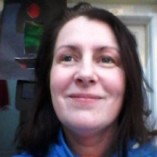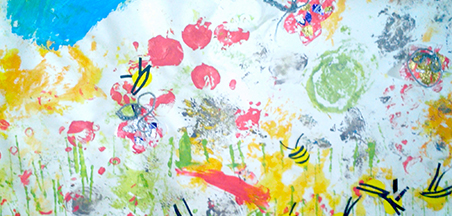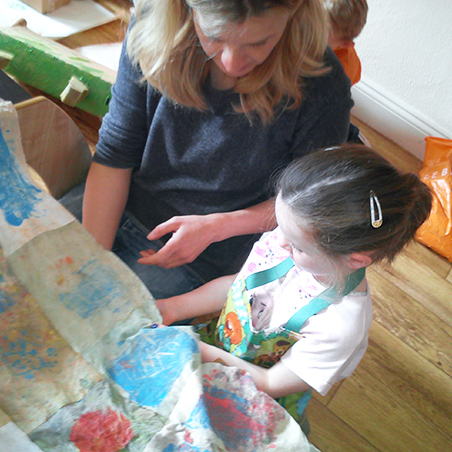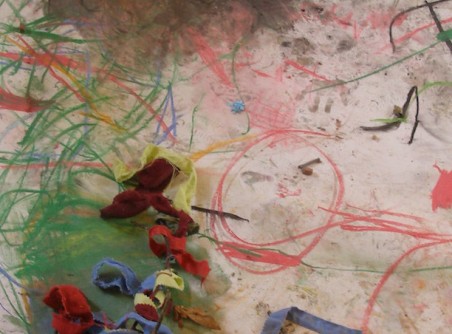Refine by Region
Refine by Art Form
Refine by School Level
Úlla Beag: Print media project

Outdoor painting
The story of our project from the teacher – Denise:
I approached Lynn in Nov 2014 to collaborate on developing an art class for ECCE in Ulla beag which would cover many art disciplines; painting, printing, working with 3 dimensional form and various craft skills to provide a more holistic teaching approach to pre-reading; pre-writing and pre-maths skills.
Collaborating with Lynn has been a great experience as we both started out with the same beliefs and ethos – We need to recycle more and look at using old materials. It is amazing how you can transform a raisin box into a robot, providing hours of fun and play for children. Through this process, children can create their own toys and the empowerment and confidence they get through using old materials is amazing.
The use of visual media as a teaching method to develop pre-reading; writing and maths skills has moved learning to a higher quality, more holistic approach at Úlla Beag.
The story of our project from the artist – Lynn:
As a group, the children worked on large pieces – printing, painting and collaging, and physically manoeuvred themselves around the piece, rather than just using their upper body, when painting. All activities gave them opportunities to strengthen their fine motor skills. They learned to work together as a group, which built up peer relationships and a joint ownership of the work they produced.
Other projects included clay modelling; and making pinch pots and papier mâché bowls, which focused on form-making, using their hands in a different way. We mono printed onto old baby wipes which was very effective and quick and explorative: some worked well, some didn’t.
We talked about the failed attempts and why this happened – too much paint, too little paint – and we tried again. Some were very keen to try stitching so we did simple long stitches through print and baby wipe. I was pleasantly surprised by how effective baby wipe material was and how easily it took the paint. It worked well with this age group as a surface to print on.
The story of our project from the children:
Through this project we experienced so many examples of children’s feedback:
“I like this way of making letters.” (Mike) This was Mike’s feedback on creating Cars from Cs; Trees from Ts and Houses from Hs. Mike found learning and retaining letters difficult until we started creating associations with every day items in picture format. As an educator you know children learn in different ways and while mainstream teaching of phonics through song & rhyme may work for most children, it does not work for all. One of the critical areas as an educator is to acknowledge this and find a new method of teaching to enable the child.
“I don’t like the way the glue makes my fingers sticky but I want to make my bowl so I will get sticky fingers and then I will have a bowl.” Mary’s feedback on papier mâché technique.
“I don’t mind if I stick the needle on my finger I want to sew a cross and I am getting better at seeing where the needle comes out so I don’t catch my finger!” (Imogen)
“I like using this as sometimes I drop my paintbrush” Oscar (aged 2 1/2) discussing his preference for using cotton buds when painting a picture.
“I am really good at making robots.” (Charlie)
“I made a hole in my picture and had to start again I put too much water on.” (Amelia)
“I feel calm when I paint.” (Thaidhg)
“I mix red and blue for purple. Sometimes I remember how to make orange too, that’s yellow and red, but sometimes I forget so I have to mix different colours together.” (Eibhe)
“I like printing with toothbrushes its cool. They are old toothbrushes though, not new ones.” (Saoirse)
The flow of our art days included: Preparation of room and materials (Lynn); Group discussion with the children -remembering the last class; reviewing the work completed. (This is important for continuity and information processing for children at this age.) Getting ready – Aprons on and discussion with the children of what art lesson is taking place.
After learning techniques from Lynn, the children start to experiment and create, with assistance from Lynn and Denise where needed. Some children finish earlier so they then get to create their next adventure while the other children are given time or guidance to finish their work.
Closing discussions with the children reinforced lessons learned – what the children liked or would change for the next time. Again this is very important in supporting communication skills and information processing with children at a preschool level. This was followed by forward planning – including the children in a discussion of what will take place the following week. At the end, everyone tidies up together.
The biggest smile for both of us was the significant level of pride the children had in their group and individual work. It was amazing seeing the children develop into a strong unit that were as happy with their group projects as they were with their individual works – which really allowed them to feel a sense of identity and belonging within the group. The children are more inquisitive about everything around them – both in and out of school they are talking about their colours and making new things from old things.
The main challenge was keeping the projects age appropriate so the children were not over-dependent on us to intervene and help and really only needed to call on us in real emergencies – such as the glue sticking their fingers together!
Some insights:
•Group Art projects even at an early years level promoted leadership within the group and fostered team work and empathy amongst the children.
•Art as a teaching process facilitates a safe environment to allow children to fail and start again – a valuable life lesson the children had to figure out with us why things did not always work out. (e.g. Not enough paint applied, Not leaning hard enough to print, yellow will not print out on the recycled wipes etc.)
•Learning to fail and recover / find new solutions is very important to instilling creativity and resilience in children. With print media the children very quickly saw what worked and did not work and the results were immediate.
•Art is a fantastic medium to foster child-led learning and child-led planning as it is such a creative process the children were completely open and could be masters of their own destiny!
•As a result of this collaboration through art with the children we display, discuss and review each others’ work together as part of the art classes. This allows the children to learn more from each other, praise each other, get praise from each other, empathise with each other when something does not work, help each other out more. This is very important in relation to wellbeing, identity and belonging and developing empathy and communication skills with peers, teachers and parents.
Changes and new developments from the project:
The project has resulted in the expansion of the group to include pre-ECCCE children. Art practice has been integrated within daily lessons at Úlla Beag.
There is now stronger and higher quality integration of art-based work into our An Taisce Green Flag Awards process. We are currently on our Water flag and have started gathering recycled materials to create a water lifecycle group exhibition in January, which will be published as part of our Green Flag presentation in March.
More time is allowed for creativity – previously we would have integrated a lot of art work with our children but now we have introduced an element of child-led choice.
We have moved from a reactive solution to a proactive learning environment. That is to say in Year 1 combining phonics and visual art printing allowed us to react to a situation where some children were really struggling to grasp phonetical learning – so we worked together to create a more visual understanding of C. This brought 3 of the more visual learners on a par with their peers and their love of phonics quickly developed. In Year 2 we are seeing very little disparity amongst the children as it is a more holistic and inclusive approach, so we are combining visual printing and other art techniques with phonetical learning.
We have collaborated on Easter and Summer camp art days and these are a great hit with the afterschool groups who come to Ulla Beag.
Spotlight
Artist(s):
Artist Lynn Kenny uses stitch with fabrics and recycled materials, but she also loves to incorporate paint and paper into her work and the technique she has devised allows her to combine all of these.
Teacher(s):
Denise Sheridan is a preschool & after-school teacher. After spending 12 years working in global project management for a multinational company Denise took time out to concentrate on finding a career path that would give back more to her children, family and the local community. With this in mind she set up Úlla Beag up as a Green school providing pre and after school Care in Ogonnelloe Co Clare. At Úlla Beag the staff work predominantly outside with the children following the Aistear the Irish play based curriculum and we incorporate best practice from Montessori, Irish Language for Early Years, Forest Schools; Waldorf Steiner and Te Waikiri (New Zealand Early Years Curriculum).
www.ullabeag.ie

Artist(s)
Lynn Kenny

Teacher(s)
Denise Sheridan
Artforms
School Level
School/
Participant Group
Úlla Beag
No. Participants
18
Region
Age/Class
ECCE Years 1 & 2 (ages 3-5 years)
Dates
Jan-June 2015, Sept 2015-June 2016
Weblinks
Key themes/ lines of enquiry
How can we integrate art into our curriculum to create a more inclusive teaching and learning process by:
•Bringing play and art into learning
•Bringing learning to life – helping the children bring letters and numbers to life for cognitive developmental support.
•Helping strong visual learners who are struggling with phonics to “see, touch, feel, create” the letters.
•Creating scenarios where children can create colours – mixing as part of pre-maths skills development.
•Facilitating large group projects which have more of a visual impact for the children.
•Creating opportunities for shared adult and child-led learning.
•Creating ownership in the process for the children themselves.
•Extending learnings from this project into our work with the pre-ECCE groups (e.g. 2-3.5 year olds)
Curriculum Strands
Integration of visual print media into Aistear and Siolta allowed us to meet the challenge of providing a learning environment which meets the learning goals within Well Being; Identity and Belonging; Communication and Exploring and Thinking.
As an educator you know children learn in different ways...One of the critical areas as an educator is to acknowledge this and find a new method of teaching to enable the child.
Denise Sheridan, Úlla Beag




Similar Projects

Artful Dodgers
A unique early years arts education programme taking place in two community crèche services in Fingal, north county Dublin.